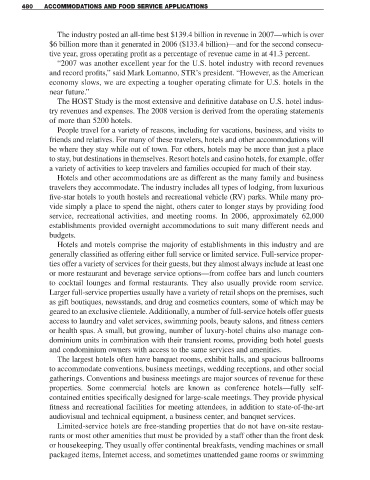Page 502 - Solid Waste Analysis and Minimization a Systems Approach
P. 502
480 ACCOMMODATIONS AND FOOD SERVICE APPLICATIONS
The industry posted an all-time best $139.4 billion in revenue in 2007—which is over
$6 billion more than it generated in 2006 ($133.4 billion)—and for the second consecu-
tive year, gross operating profit as a percentage of revenue came in at 41.3 percent.
“2007 was another excellent year for the U.S. hotel industry with record revenues
and record profits,” said Mark Lomanno, STR’s president. “However, as the American
economy slows, we are expecting a tougher operating climate for U.S. hotels in the
near future.”
The HOST Study is the most extensive and definitive database on U.S. hotel indus-
try revenues and expenses. The 2008 version is derived from the operating statements
of more than 5200 hotels.
People travel for a variety of reasons, including for vacations, business, and visits to
friends and relatives. For many of these travelers, hotels and other accommodations will
be where they stay while out of town. For others, hotels may be more than just a place
to stay, but destinations in themselves. Resort hotels and casino hotels, for example, offer
a variety of activities to keep travelers and families occupied for much of their stay.
Hotels and other accommodations are as different as the many family and business
travelers they accommodate. The industry includes all types of lodging, from luxurious
five-star hotels to youth hostels and recreational vehicle (RV) parks. While many pro-
vide simply a place to spend the night, others cater to longer stays by providing food
service, recreational activities, and meeting rooms. In 2006, approximately 62,000
establishments provided overnight accommodations to suit many different needs and
budgets.
Hotels and motels comprise the majority of establishments in this industry and are
generally classified as offering either full service or limited service. Full-service proper-
ties offer a variety of services for their guests, but they almost always include at least one
or more restaurant and beverage service options—from coffee bars and lunch counters
to cocktail lounges and formal restaurants. They also usually provide room service.
Larger full-service properties usually have a variety of retail shops on the premises, such
as gift boutiques, newsstands, and drug and cosmetics counters, some of which may be
geared to an exclusive clientele. Additionally, a number of full-service hotels offer guests
access to laundry and valet services, swimming pools, beauty salons, and fitness centers
or health spas. A small, but growing, number of luxury-hotel chains also manage con-
dominium units in combination with their transient rooms, providing both hotel guests
and condominium owners with access to the same services and amenities.
The largest hotels often have banquet rooms, exhibit halls, and spacious ballrooms
to accommodate conventions, business meetings, wedding receptions, and other social
gatherings. Conventions and business meetings are major sources of revenue for these
properties. Some commercial hotels are known as conference hotels—fully self-
contained entities specifically designed for large-scale meetings. They provide physical
fitness and recreational facilities for meeting attendees, in addition to state-of-the-art
audiovisual and technical equipment, a business center, and banquet services.
Limited-service hotels are free-standing properties that do not have on-site restau-
rants or most other amenities that must be provided by a staff other than the front desk
or housekeeping. They usually offer continental breakfasts, vending machines or small
packaged items, Internet access, and sometimes unattended game rooms or swimming

